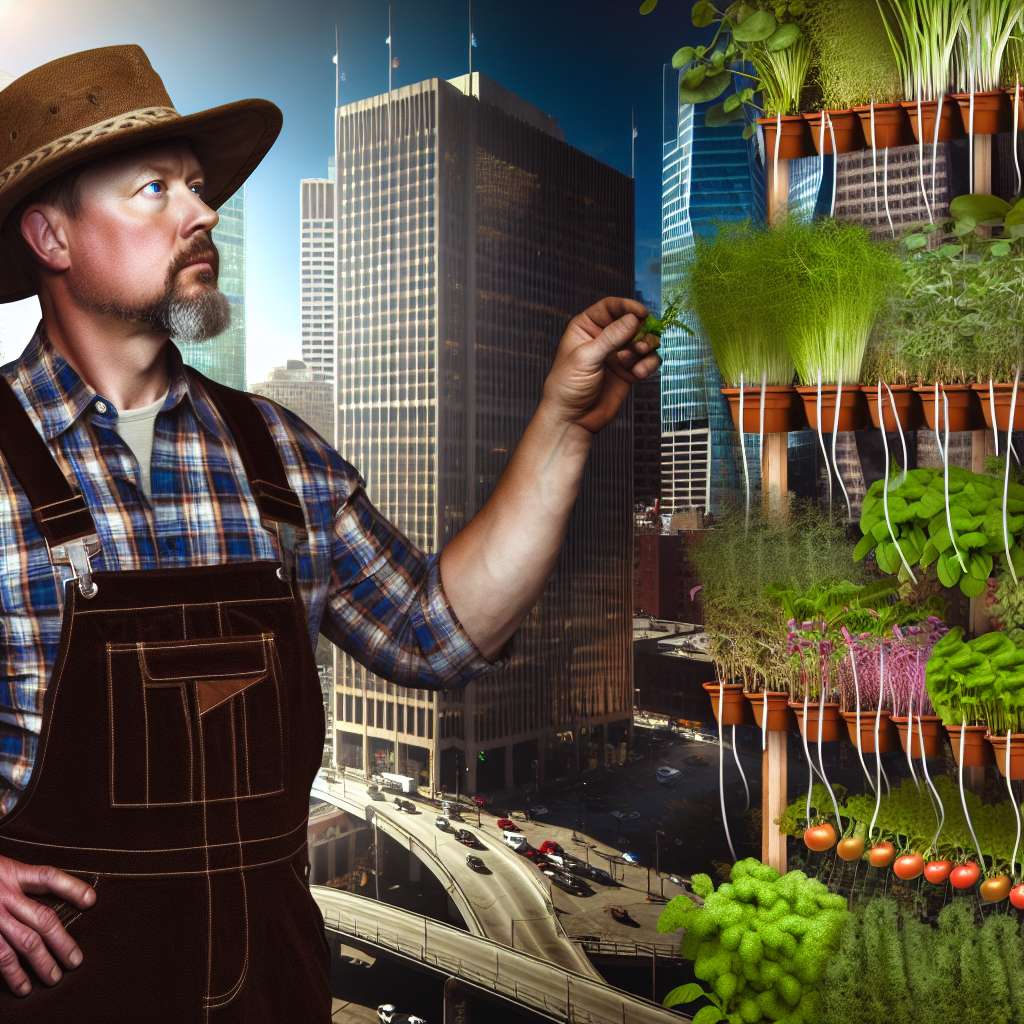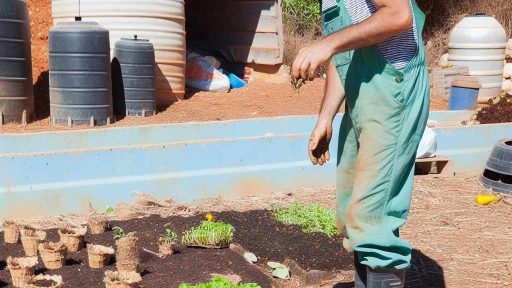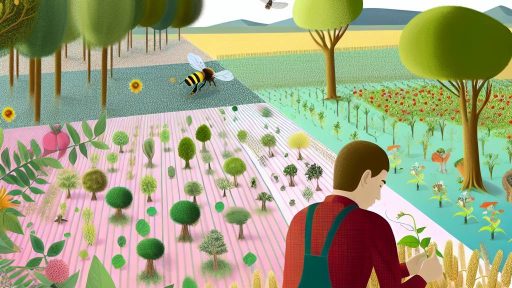Introduction to Urban Farming
Definition of Urban Farming
Urban farming refers to the practice of cultivating, processing, and distributing food within urban environments.
It includes activities such as gardening, farming, and aquaponics.
Moreover, urban farming aims to improve local food security.
Importance of Urban Farming
Urban farming plays a crucial role in enhancing community resilience.
It contributes to a sustainable local food system.
Furthermore, it provides fresh produce to urban residents throughout the year.
Environmental Benefits
Engaging in urban farming helps reduce transportation emissions.
It also promotes biodiversity in densely populated areas.
Additionally, urban farms can improve air and soil quality.
Social and Economic Impact
Urban farming fosters community engagement and social interaction.
It can create job opportunities in local food production.
Moreover, it encourages local entrepreneurship by supporting small businesses.
Challenges of Urban Farming
Urban farming faces challenges such as limited space and resources.
Access to land and water can also be a significant issue.
Additionally, regulatory barriers often hinder urban farming initiatives.
Transform Your Agribusiness
Unlock your farm's potential with expert advice tailored to your needs. Get actionable steps that drive real results.
Get StartedBenefits of Vertical Gardening for Space Maximization
Efficient Use of Limited Space
Vertical gardening utilizes vertical surfaces effectively.
This method maximizes growing area without expanding the footprint.
It allows urban dwellers to cultivate more plants in less space.
Moreover, it accommodates diverse plant types in various arrangements.
As a result, apartment dwellers can enjoy fresh produce all year round.
Improved Microclimate
Vertical gardens create a unique microclimate for plants.
They provide shade and reduce temperature fluctuations.
This effect promotes healthier plant growth.
Also, vertical structures can minimize wind exposure for delicate plants.
Consequently, this results in higher yields from limited areas.
Enhanced Aesthetics and Air Quality
Vertical gardens enhance the visual appeal of urban spaces.
They introduce greenery in dense city areas, promoting a serene atmosphere.
Plants naturally filter air pollutants, improving air quality.
This benefit contributes to a healthier living environment.
Additionally, greenery can elevate mental well-being for residents.
Accessibility and Maintenance
Vertical gardens can enhance accessibility for urban gardeners.
They reduce the need to bend or kneel while gardening.
This feature appeals to individuals with mobility challenges.
Furthermore, using stacked pots simplifies maintenance tasks.
As a result, care routines become more efficient and enjoyable.
Encouragement of Sustainable Practices
Vertical gardening promotes sustainable urban practices.
It encourages local food production in urban areas.
This reduced transportation contributes to lower carbon footprints.
Additionally, vertical gardens can decrease stormwater runoff.
Showcase Your Farming Business
Publish your professional farming services profile on our blog for a one-time fee of $200 and reach a dedicated audience of farmers and agribusiness owners.
Publish Your ProfileIn turn, this practice supports local ecosystems and wildlife.
Types of Urban Farming
Rooftop Gardens
Rooftop gardens maximize space in densely populated areas.
They utilize unused rooftops for growing plants.
These gardens provide fresh produce right where it’s needed.
Additionally, they help reduce urban heat and improve air quality.
Community members can create a shared garden space on rooftops.
Balcony Gardens
Balcony gardens make use of small outdoor spaces.
These gardens allow individuals to grow herbs and vegetables.
Vertical planters work well in limited space scenarios.
Moreover, they can easily be personalized to fit aesthetic choices.
Balcony gardens greatly enhance urban biodiversity.
Community Gardens
Community gardens foster collaboration among local residents.
They transform vacant lots into productive green spaces.
Such gardens provide a sense of ownership and community pride.
Members work together to grow produce, sharing the harvest.
This setup encourages social interaction and skill sharing.
You Might Also Like: Farm-To-Table Pop-Ups for Direct Farmer-to-Chef Ingredient Sourcing
Essential Tools and Materials for Vertical Gardening
Planning Your Vertical Garden
Start by determining the available space for your garden.
Assess the amount of sunlight the area receives daily.
Next, choose a theme for your vertical garden.
Consider the types of plants that will thrive in your chosen environment.
Choosing the Right Containers
Select containers that suit the plants you wish to grow.
Vertical gardening systems include wall planters, pots, and trellises.
Ensure containers have good drainage to prevent waterlogging.
Using lightweight materials makes installation simpler.
Building or Buying a Framework
Consider various frameworks, including wood and metal structures.
Pre-made vertical garden kits are also available online.
If you prefer DIY, gather materials like wooden pallets or wire grids.
Ensure the framework is sturdy to support the weight of the plants.
Soil and Fertilizers
Choose high-quality soil that retains moisture yet drains well.
Mix compost for added nutrients and healthier plants.
Consider organic fertilizers for optimal plant growth.
Regularly monitoring soil pH helps maintain a healthy garden.
Plant Selection
Select plants based on their light and water needs.
Consider herbs, vegetables, and ornamental plants for variety.
Fast-growing plants like lettuce and herbs are ideal for vertical gardens.
Perennials can also bring long-lasting beauty to your structure.
Irrigation Systems
Implementing a drip irrigation system can save water and effort.
This approach allows for consistent moisture levels across all plants.
Make sure to establish a watering schedule based on plant needs.
Showcase Your Farming Business
Publish your professional farming services profile on our blog for a one-time fee of $200 and reach a dedicated audience of farmers and agribusiness owners.
Publish Your ProfileConsider rainwater collection for an eco-friendly approach.
Maintenance Tools
Gather essential tools like pruners, gloves, and watering cans.
A ladder or stool might be necessary for easy access.
Regularly check for pests and diseases to keep your garden healthy.
Document growth progress to adjust care as needed.
Gain More Insights: Farm Fresh Delivery Services for Community Supported Agriculture
Soil and Hydroponics: Choosing the Right Growing Medium
Understanding Soil as a Growing Medium
Soil is the traditional choice for growing plants.
It offers essential nutrients and supports microbial life.
Using high-quality soil improves plant health significantly.
Organic matter enriches soil and enhances its moisture retention.
Soil pH should match the needs of your plants.
Testing soil pH is a straightforward process.
Amend your soil based on pH test results.
Consider incorporating compost for added nutrients.
However, soil can be heavy and challenging to manage in urban settings.
Exploring Hydroponics as an Alternative
Hydroponics is gaining popularity among urban farmers.
This method uses nutrient-rich water instead of soil.
It allows for faster plant growth and higher yields.
Hydroponics requires less space, making it ideal for vertical gardening.
Various systems, like nutrient film technique or deep water culture, exist.
Each system offers distinct advantages based on your setup.
Properly balancing nutrients is crucial for success.
Monitoring pH levels in hydroponics is essential.
Cleanliness is key to preventing diseases in hydroponic setups.
Comparing Soil and Hydroponics
Both soil and hydroponics have their unique benefits.
Soi often is more forgiving for beginners.
Hydroponics can produce crops in limited space.
Soil typically retains moisture better than hydroponic systems.
Conversely, hydroponics can reduce pest issues significantly.
Deciding which method to use depends on your preferences.
Consider your space, budget, and desired crop types.
Ultimately, the right choice enhances your urban farming experience.
Making the Right Choice for Your Garden
Identify your gardening goals before selecting a medium.
Research your target crops and their specific needs.
Experiment with both methods if possible.
Document your observations to refine your approach.
Both soil and hydroponics can coexist in an urban farm.
Combining methods may yield the best results.
Finding the right growing medium is crucial for success.
By understanding your options, you’ll make informed decisions.
Showcase Your Farming Business
Publish your professional farming services profile on our blog for a one-time fee of $200 and reach a dedicated audience of farmers and agribusiness owners.
Publish Your ProfileHappy gardening!
Discover More: Farm Fresh Delivery Services for Locally Sourced Produce
Plant Selection: Best Crops for Urban Vertical Gardens
Key Considerations for Crop Selection
Choosing the right plants is essential for successful urban vertical gardens.
Consider the available sunlight, space, and climate conditions.
Suitable crops will maximize your yield in limited areas.
Leafy Greens
Leafy greens are a popular choice for vertical gardening.
They grow quickly and thrive indoors and outdoors.
Options like spinach, kale, and lettuce are excellent choices.
These plants need moderate light and can tolerate some shade.
Herbs
Herbs are perfect for vertical gardens due to their compact growth.
Choose from basil, parsley, cilantro, and mint.
They require minimal space and can be harvested frequently.
Additionally, herbs can enhance flavors in cooking.
Fruiting Plants
Fruiting plants add variety to your vertical garden.
Consider dwarf varieties of tomatoes and peppers.
These plants can thrive in potting mixes and limited space.
Ensure they receive adequate sunlight and watering.
Flowering Plants
Incorporating flowering plants enhances aesthetics and attracts pollinators.
Good options include nasturtiums and petunias.
These flowers can grow alongside herbs and vegetables.
They require similar care and conditions.
Vertical Gardening Techniques
Using appropriate techniques boosts plant health and productivity.
Employ trellises, hanging pots, or wall-mounted planters to save space.
These methods improve air circulation and light exposure.
Experiment with stacking systems for maximizing vertical space.
Seasonal Planting
Consider the seasons when choosing your crops.
Some plants thrive in specific conditions and temperatures.
Rotate your crops to keep the garden productive year-round.
This practice also helps maintain soil health.
Gain More Insights: From Crop Rotation To Artisan Bread: Connecting Sustainable Wheat Sources

Designing Your Vertical Garden
Choosing the Right Location
Start by assessing the available spaces in your environment.
Consider areas with ample sunlight for optimal plant growth.
Avoid places with excessive wind or shade from buildings.
Look for sturdy walls or structures to support your vertical garden.
Creating a Functional Layout
Begin with a basic sketch of your vertical garden layout.
Identify the types of plants you want to grow and their space requirements.
Group plants with similar light and watering needs together.
Incorporate shelves or grids for better organization.
Utilizing Vertical Space
Use wall-mounted planters to maximize vertical space.
Consider tiered shelving units for multiple layers of plants.
Showcase Your Farming Business
Publish your professional farming services profile on our blog for a one-time fee of $200 and reach a dedicated audience of farmers and agribusiness owners.
Publish Your ProfileHanging pots and vertical frames also add depth to your design.
Selecting Aesthetic Elements
Choose a color palette that complements your outdoor or indoor decor.
Incorporate decorative pots and plant stands for visual appeal.
Use trellises or lattice for climbing plants to add texture.
Incorporating Lighting Solutions
Consider using LED grow lights if natural sunlight is limited.
Install ambient lighting to enhance the garden’s aesthetic at night.
Make sure that the lighting solutions are energy-efficient.
Maintaining Accessibility
Design the layout for easy access to all plants.
Ensure pathways or stepping stools are included as necessary.
Leave enough space to maneuver around your garden comfortably.
Adding Watering Systems
Consider integrating a drip irrigation system for consistency.
Use self-watering pots to simplify maintenance.
Make sure to check water drainage in your design.
Choosing the Right Plants
Select plants that thrive in your specific light conditions.
Opt for herbs or small vegetables for a multifunctional garden.
Incorporate flowers for color and variety.
Experimenting and Adapting
Don’t be afraid to experiment with different plant combinations.
Observe how plants perform and adapt your garden accordingly.
Regularly update your design to keep the garden fresh and engaging.
Sustainable Practices in Urban Farming
Water Conservation
Water conservation plays a crucial role in urban farming.
Efficient water use helps reduce overall consumption.
Implementing rainwater harvesting systems can capture valuable resources.
These systems collect and store water for irrigation.
Furthermore, drip irrigation delivers water directly to plant roots.
This reduces evaporation and runoff significantly.
Using drought-resistant plants can also conserve water.
These plants require less water, making them suitable for urban gardens.
Cultivating ground cover crops helps retain soil moisture.
Additionally, using mulch regulates soil temperature and reduces evaporation.
Proper soil management enhances water retention as well.
Composting
Composting is an effective way to manage organic waste.
It transforms kitchen scraps and yard waste into valuable compost.
This enriches the soil and reduces landfill contributions.
Many urban farmers start compost bins in their backyards.
Composting promotes soil health and reduces soil erosion.
Utilizing diverse materials boosts nutrient content in compost.
Kitchen waste, leaves, and grass clippings serve as excellent inputs.
Creating a balanced compost pile supports efficient decomposition.
Finally, following best practices enhances the composting process.
- Mix green and brown materials in equal parts.
- Turn the pile regularly to aerate it.
- Monitor moisture levels to optimize conditions.
Challenges of Urban Farming and Solutions
Limited Space Availability
Urban areas often lack space for traditional farming.
Showcase Your Farming Business
Publish your professional farming services profile on our blog for a one-time fee of $200 and reach a dedicated audience of farmers and agribusiness owners.
Publish Your ProfileThis limitation poses challenges for growing a variety of plants.
To address this, urban farming employs vertical gardening techniques.
Vertical gardens maximize limited area and blend with surroundings.
They utilize walls, balconies, and rooftops effectively.
Poor Soil Quality
Many urban soils are contaminated or poor in nutrients.
This condition restricts plant growth and health.
To combat this, urban farmers use raised beds with quality soil.
Soil amendments such as compost can enhance fertility.
Moreover, hydroponics allows for soil-less growing options.
Water Management Challenges
Urban settings may face inconsistent water supply.
Additionally, water runoff can lead to water waste.
Implementing rainwater harvesting systems can conserve water.
Drip irrigation systems also minimize water usage effectively.
Such solutions ensure plants receive adequate hydration.
Community Engagement and Support
Urban farming often struggles with community involvement.
Many residents may not understand its benefits.
To overcome this, educational programs can raise awareness.
Workshops and community events foster interest and participation.
Partnerships with local organizations can also boost support.
Regulatory Hurdles
Government regulations sometimes hinder urban farming initiatives.
This includes zoning laws and land usage restrictions.
Advocacy groups can influence policy changes positively.
Additionally, lobbying for supportive legislation can create opportunities.
Engaging with local authorities can also streamline processes.
Case Studies: Successful Urban Farming Projects Around the World
Green City Farms in Baltimore, Maryland
Green City Farms operates on a small plot in the heart of Baltimore.
This urban farm utilizes innovative techniques to maximize space.
They employ vertical gardening methods for efficient crop production.
Additionally, they focus on community engagement and education.
Local residents participate in workshops to learn sustainable practices.
The Rooftop Project in New York City
The Rooftop Project transforms rooftops into vibrant gardens.
It showcases how vertical gardening can thrive in limited space.
This initiative promotes green spaces amid concrete landscapes.
Furthermore, it offers fresh produce to surrounding communities.
The project encourages urban residents to grow their own food.
Urban Farm at the University of California
The Urban Farm at UCLA serves as an educational tool.
Students learn about sustainable agriculture and food systems.
This initiative applies vertical gardening techniques in an urban setting.
Moreover, it practices organic farming methods to encourage healthy eating.
The farm also supports research on urban agriculture solutions.
Farming the Future in Singapore
Farming the Future combines technology with urban farming.
Showcase Your Farming Business
Publish your professional farming services profile on our blog for a one-time fee of $200 and reach a dedicated audience of farmers and agribusiness owners.
Publish Your ProfileThey introduce hydroponics and aquaponics to maximize productivity.
This initiative addresses the lack of land available for traditional farming.
As a result, it provides fresh herbs and vegetables year-round.
The project emphasizes the importance of food security in urban areas.
GrowIt in Melbourne, Australia
GrowIt focuses on creating green spaces in densely populated areas.
They utilize container gardening to enhance vertical gardening efforts.
This approach encourages urban dwellers to engage with gardening.
Additionally, GrowIt hosts workshops to promote sustainable practices.
The project’s community involvement fosters a sense of belonging and responsibility.




